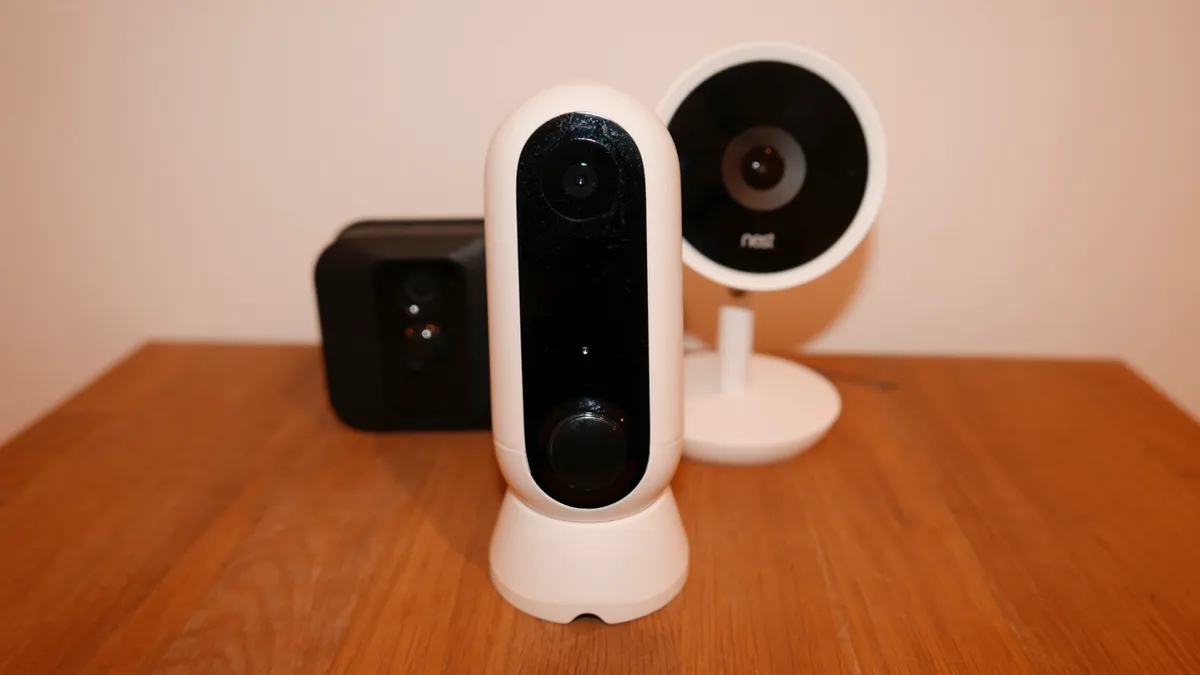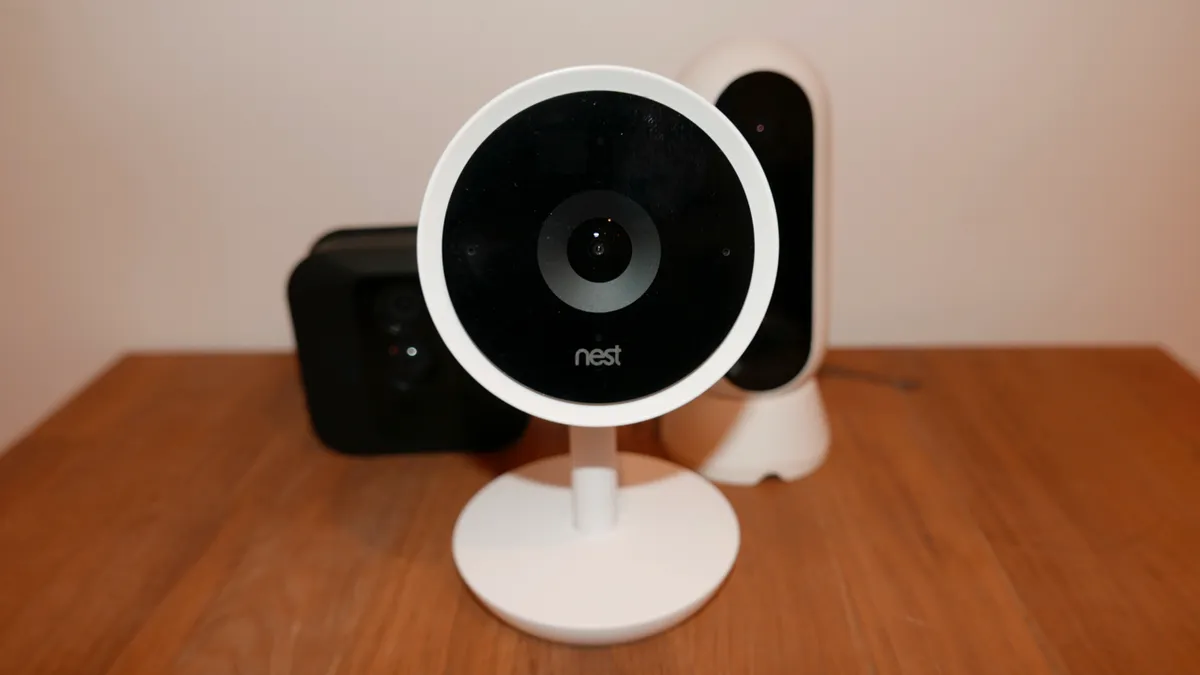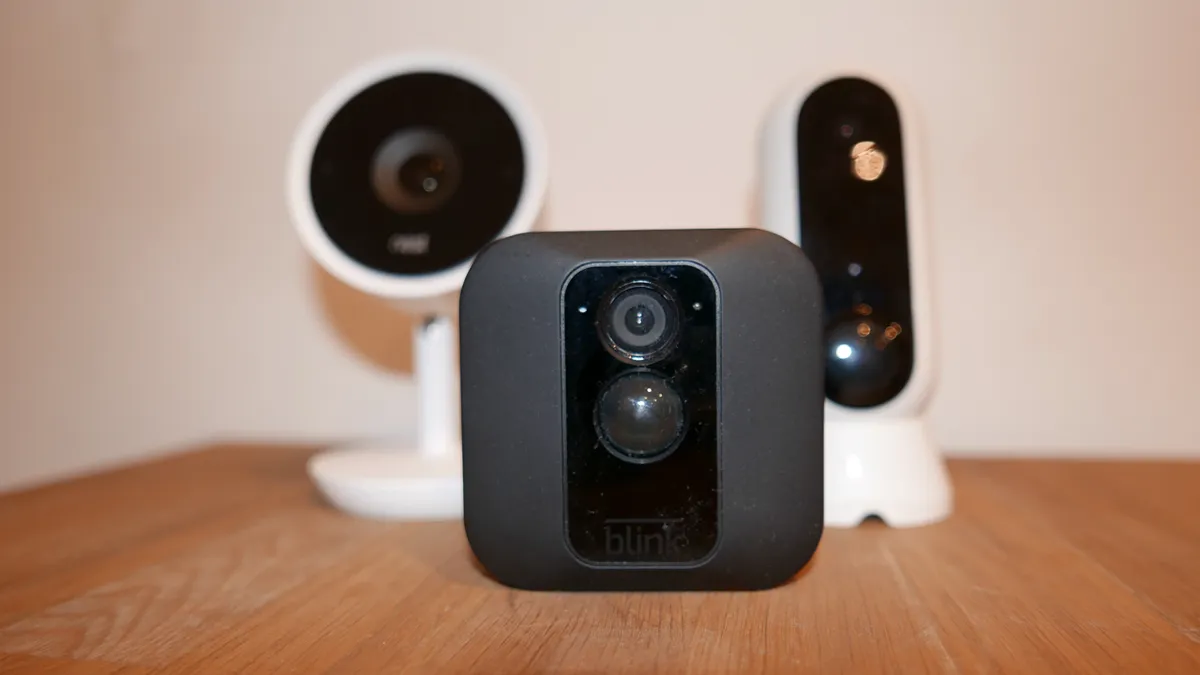Nothing is more likely to make these long, dark nights even gloomier than the prospect of having someone sneak in your house while you’re away (or even in bed!) and nicking all your best gadgets. Fortunately, it’s 2018 and our homes are officially smart now. One of the better ways to secure peace of mind is by installing a security camera. I’m not talking about those ugly Big-Brother-is-watching-you CCTV camera, but farmore elegant ones that blend into your carefully designed living room or in the garden. I’ve been testing out three good home security cameras, the Canary Flex, Blink XT and Nest Cam IQ, for the last month to find out which I reckon is the best and would entrust the safety of my Aladdin’s Cave of tech family with.
Canary Flex

Price: £199, canary.is
Camera: HD Camera with 1080p image sensor
Field of view: 116° wide-angle lens
Storage: 30-day video history (+£79 a year)
The Canary Flex is a weatherproof security camera good for using inside and outside the home, and so long as you don’t mind taking it down to charge every once in a while, being wireless it means you can fix it just about anywhere you like. This makes it an extremely versatile piece of kit, especially with the strong magnet holding it securely to the base, and the pill-shaped camera actually looks pretty good too. The camera itself is full HD and can record good quality video at 1080p, so you should be able to pick out the face of any would-be burglar with ease, and the 116° wide-angle lens is plenty wide enough to get a decent view of the world around it. Motion detection is also very reliable, in my case picking up people walking along the street at the edge of the camera a good four metres away (I quickly had to be reposition it so that I didn’t get notified every few minutes at work). This can be tweaked in the app to pick out movement even further away, although this will definitely affect battery life.
Unfortunately, there are a few issues with the camera that really limits its appeal. Firstly, the battery life didn’t last anywhere near enough to put my mind at ease. Being magnetic, although firmly attached to the base, it wouldn’t take any effort for anyone to just pull it down, so positioning it far or high enough away from reach is pretty important. But I got around a week out of it before it needed recharging, and personally I don’t fancy clambering up a ladder every weekend to charge it up. It’s something that is probably going to be an issue with most outdoor wireless cameras, and one you can get around by tweaking the camera settings to only detect motion close by, or by plugging it into an external power socket, but then that defeats the point of getting a wireless security camera in the first place. The mount itself also seemed a little flimsy, trying to hold they weighty (240g) device up and steady with just one screw. Overall it would have been better to solve both problems and come with the official, sturdier and more secure external mount (£30) in the first place.

Secondly, unless you subscribe to the Canary Membership (£7.99 a month or £79 for the year), you really limit what you can do. Without membership you can only keep short video clips for 24 hours, and unlike the Nest Cam, which also requires a subscription, you cannot download them for evidence. Other features you miss out on without subscribing are being able to speak through the camera, desktop streaming and incident support services. In other words, you’ll want membership to get the most out of it, so factor that into your costs.
This is a bit of downer, but despite these problems it is still a pretty good camera that works well in both light and dark conditions and the app is simple to use and integrates with Alexa and Google Home
Nest Cam IQ indoor

Price: £299, nest.com/uk
Camera: 8-megapixel colour sensor with 12x digital zoom and enhance, 1080p video HDR
Field of view: 130° diagonal
Storage: 10-day cloud storage (+£80 a year) or 30-day (+£240 a year)
If you want the best picture and the richest feature set from your smart security camera, the Nest Cam IQ is easily the best of the bunch, but it comes at a high cost. The Nest IQ is priced £100 dearer than the Canary Flex, and that’s before you factor in almost the price of a whole camera again if you want the 30-day video storage subscription (there is the option of the cheaper 10-day storage as well). So, what does it do that the others can’t? Well from the very start, this is the best-looking security camera tested. Yes, looks aren’t everything, but in general the best place to position a camera can be one of the most obvious, so having something that you’re comfortable with on show in the home is going to please anyone with any design nouse. Although it isn’t wireless, the USB-C power cable is sufficiently long enough to reach down to a plug socket near the floor, even if the camera is on the ceiling, and the speaker is loud enough to let thieves know you’re watching them (which fires up a HAL-esque ring around the lens when you’re speaking through the app).
On that note, the camera is able to pick out and recognise faces using the Nest Aware feature, one of the main features of subscribing, so it’ll send a notification to your phone if someone unfamiliar pops into view (something that is possibly too effective if you happen to point it towards the television). It will also zoom in on anything that is happening so you can get a clearer view. At times this was a little slow, so if you have someone running through the (very wide) field of view it might not always be able to catch up, but in general it does give you a better shot of what is going on.

Other features you get with the Nest Aware are activity zones, for notifications on specific areas, saving and sharing clips, and even a timelapse feature. Like the Canary Flex before, these are all pretty handy features to have (bar maybe the timelapse, which is probably more for fun more than anything else), so the Nest Cam IQ is a real investment, but if you already have a number of Nest devices in the house it’s convenient to handle everything from the one app. I already have the Nest App installed on my phone for my thermostat, and adding a new device was a breeze. It seems a little weird controlling your heating and watching security cam footage from the same place (and your fire alarm if you have the Nest Protect installed), but it means everything can work seamless together. For example, the app knows when I’m away, so it’ll switch the camera on and the heating off without me having to lift a finger. It’s that sort of integration which really makes smart homes come into their own, and is made even easier without having to prod around with recipes in If This Then That (IFTTT, which it supports).
Blink XT One Camera System

Price: £149.99, blinkforhome.co.uk
Camera: 1080p
Field of view: 110° wide-angle lens
Storage: 7,200 total seconds of video (two hours)
Compared to the Nest and the Canary, at £150 the Blink XT is already a relatively cheap wireless security camera, but when you take into account there is no subscription model it’s practically a steal (thought these were supposed to stop that sort of behaviour?!?). While it doesn’t have many of the features of the other two cameras, such as facial recognition or two-way speakers, it makes up for it by getting the basics right. The Blink XTis wireless and waterproof, the 1080p camera has a good level of detail, the field of view is plenty wide enough to get a decent look at things, even though it is tighter than the others, and it runs off regular AA batteries, apparently giving it a two-year battery life. I had it for a month so there is no way I could put that to the test, but it does suggest I could stick it somewhere pretty awkward and out of the way of any quick fingers without having to change the batteries too often. And out the way is good, it’s a pretty unappealing black box to look at (although you can get white, red or grey covers).

Although it stores around only two hours of footage in the cloud, there is nothing to pay to access and download the clips, and so long as you have sufficient space you can store them for up to one year. If you do run out, the camera will record over the oldest one, but the unit I tested was set up to record for 30 seconds, and in 14 days it has used only 35 per cent of the storage capacity, so unless you’ve skipped the country for more than a month this shouldn’t be too much of an issue. You can change how much it records in the app, which will not only increase how many clips it can record but improve the battery life. Unfortunately, the app is one of the weaknesses of the Blink XT. It’s not actually bad, but it is nowhere near as user friendly as the others. Setting up a camera involves scanning a barcode on the back of the unit itself, and once you’re up and running the app itself looks basic and is filled with settings. These are all handy tweaks for improving battery life, motion sensitivity and video quality (it even has a thermometer), but doesn’t have the polish of its rivals. For example, it can't work out your location using your phone, so you actually have to go into the app and arm the camera if you want it to guard your home. This doesn't sound much, but the icon for arming thecamera bizarrely is a running man, i had to delve into the support forums to find out what this meant, and this sort of faffery isn't something you expect from a smart device.You can get around this by using IFTTT to set up recipes, but it’s a pretty obvious thing you’d want a smart security camera to do. It was the same with arming it overnight. That said, once this is done and you’re confident it works, you can just leave it to do its magic.
Finally, unlike the other cameras, it requires a sync module to connect to the cloud, which is another additional item to add to your collection of smart hubs under the tele (although it does have a spare USB port, which is a good touch).
Verdict
Fortunately, I never had anybody try to break into my house during testing (although I was able to spot a few delivery people leaving packages in stupid places), so while I won’t be able to say how any of these cameras would fare in a court of law, they all helped me feel a little bit safer when tucking myself up in bed. I tried all the cameras all over the house, including using them as makeshift baby monitors (the Canary Flex would be my choice in this situation as there were no cables and you can watch a continuous stream of video), but what it comes down to is how much you put a price on security. The Canary Flex and the Nest Cam IQ especially are expensive options, but they both look good, have plenty of features and excellent image quality to justify the price tag. If money were no object, your house might have plenty that is rife for pilfering, so spending that extra on the Nest is probably not a problem, but for me the Blink XT’s price and ‘leave it and forget about it’ approach to security is why I would pick this over the more premium devices.
Follow Science Focus onTwitter,Facebook, Instagramand Flipboard

